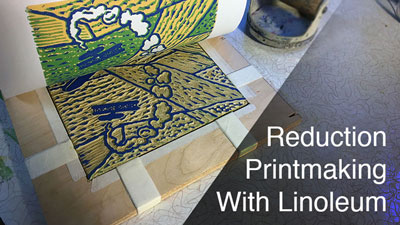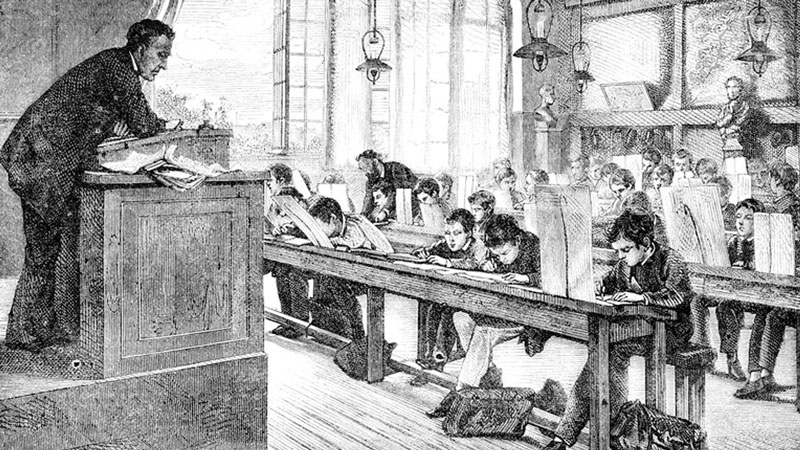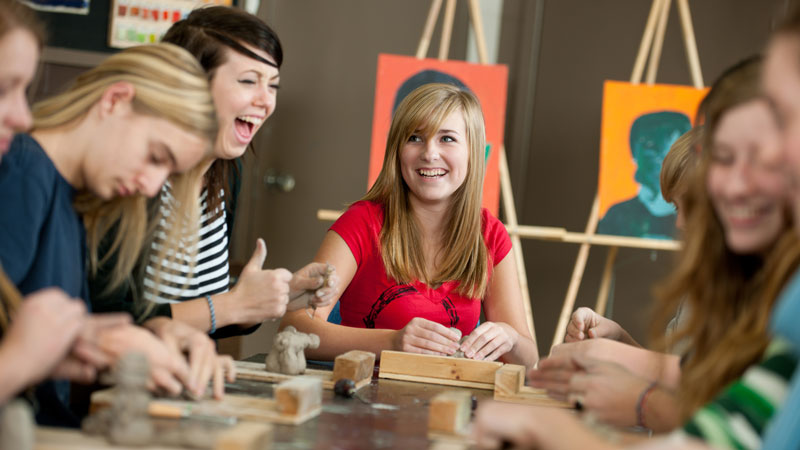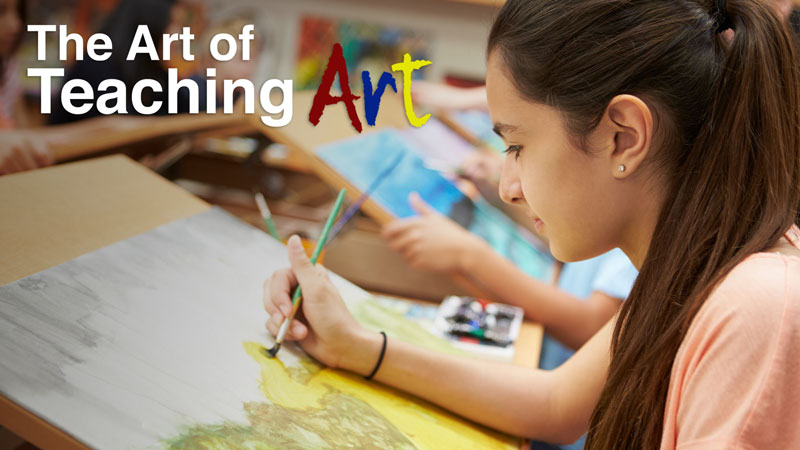
Can Art Be Taught?
Art is a discipline that can be taught. In fact, I believe that anyone can be taught to be a great artist. If I didn’t believe that as an art teacher, I would be in the wrong profession.
But art can only be taught by an effective art teacher. Unfortunately, there are far too many bad art teachers out there – those that sit behind their desks and simply hand out assignments.
If you’re an art teacher, you don’t want be a bad one. You want to be a great one – one that your students love and respect.
Teaching art is an art in itself and in this post, I’ll share with you how to be one of the great art teachers.
What Makes a Strong Teacher?
We’ve all had teachers in our lives that are memorable. Unfortunately, we remember some of them as poor teachers. For some, we only remember a little and maybe have forgotten their names or any of the details of the class they taught.
But for a few teachers, we remember them in detail and what we’ve learned in their class has stuck with us for many years. In some cases, the direction of our lives has been changed forever because of the influence of these special folks.
These teachers are the special ones. For most of us, we’ve been lucky enough to have at least one of these “super teachers” in our lives.
If teaching is your profession, then this is the kind of teacher you should strive to become.
Effective teaching is an art form. And like most forms of art, there are skills involved. Thankfully, these skills can be learned and developed. When these skills are implemented with passion and purpose, they become a characteristic of the teacher. These are the characteristics that define the strongest, most memorable, and most effective teachers.
Below, we’ll take a look at some of the unique challenges that art teachers face, how to overcome them, and most importantly – how to become an effective and memorable art teacher.
Teaching Art Is Challenging
Teaching ain’t easy. Teaching art is even harder. If you went into this thinking it would be easy, and you don’t like a challenge – then you may be in the wrong profession. But if you embrace the challenge, and pour yourself into it, then there aren’t too many greater pursuits in life – to give the gift of creative expression to a generation of students and to change people’s lives.
Art teachers unfortunately face challenges that teachers from core subjects usually don’t have to deal with. Identifying these challenges and knowing how to handle them is essential to your success.
Fighting the Myth of Talent
Many people believe that artists are born that way – that talent can’t be taught – and that you are just an overseer of people that have “talent”. If you believe that you must have talent to acquire artistic skill, then what business do you have in art education. Talent is a myth and you must believe this.
The problem is, many people do not believe this. Instead, they buy into the lie of talent and conclude that since art is a talent – you either got it or you don’t.
As an art teacher, I deal with this misconception daily. People make excuses based on this misconception, and if you’re an art teacher and you buy in to it, your students will suffer. The first principle in becoming an effective art teacher is to drop the word “talent” from your vocabulary.
If your students believe in talent, and have never been labeled as “talented”, then chances are, they will never truly believe that they can create good art. And if you believe the myth of talent yourself, you may not believe that they can produce good art either. This handicaps you right from the start. So, get rid of “talent” and make your students aware of your position.
Micheal Jordan is perhaps the greatest basketball player to have ever lived. Some would venture to say that he is also the most “talented” basketball player to play the sport. Here a few interesting facts about him…
- Holds the record for regular season career scoring average. (30.12 points a game)
- The only player to score 40+ points in a game at age 40 or older.
- In 1989, he recorded 10 triple doubles in 11 games.
- The only player to win the scoring title and Defensive Player of the Year – in the same year.
- Cut from the high school basketball team.
Did you pay attention to that last stat? He was cut from the high school basketball team!
That’s right, Michael Jordan was not “talented” enough to make the basketball team at his own high school the first year he tried out. Was it because he wasn’t talented? No, it was because he hadn’t worked hard enough and practiced enough to hone his skills. He had not developed his skills, he needed work.
We aren’t born with talent. We develop skills and over time people begin to recognize these skills and label us as “talented”. Anyone can become “talented” if they are willing to learn and practice. This is true for all of your students. Any of your students can become incredible artists. But first, they must believe that this is possible and you must believe it too.
A Lack of a Pacing Guide
You do not have a defined pacing guide that spells out what you should teach and when you should teach it. This freedom is great, but it can present challenges to art teachers. Math teachers, for example, know what they are to teach and what day they should teach it. It’s very straight-forward. We don’t have this.
You must be organized enough to plan a defined curriculum for your students. Your curriculum should be logically sequenced and designed to maximize the success of your students. It should be well-paced and complete.
A Lack of Respect From Core Teachers and Administrators
We often don’t get the same respect as teachers in the “core” subjects – from other teachers, administrators, and parents. This disrespect carries over to our students, so we have to work harder to get it and keep it.
We can gain the respect of other teachers and administrators by taking steps to display the work and progress of our students. Artwork should be prominently displayed around the school and even throughout the community. Create art events at your school to involve the community and communicate the importance of your program.
The more that the community notices, the more that your administrators will support your program. With additional support, you may find that your allotted budget grows as well. Administrators will put money in programs that make the school look its best. Make sure that your program is a shining star!
No, teaching art ain’t easy, but it’s what we do and I’d like to share with you how to come to P.E.A.C.E. with it all.
P.E.A.C.E. in the Art Classroom
Effective teachers produce students that create quality artwork. It doesn’t matter where you teach. It doesn’t matter your budget. It doesn’t matter your school’s demographics or socio-economic factors. If you are a strong teacher, you will have strong art students.
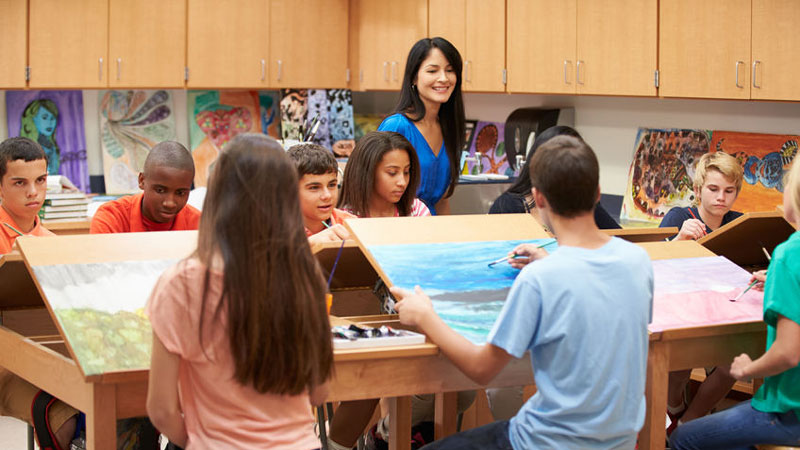
Producing strong students doesn’t happen overnight – it is the direct result of you and how you conduct your classroom. Finding peace in your classroom and becoming an effective art teacher is all about…
- P – Preparation
- E – Expertise
- A – Art Activities
- C – Curriculum
- E – Empathy
Let’s examine each of theses strategies and characteristics a little deeper…
Preparation
One important key to success is self-confidence – an important key to self-confidence is preparation.
Planning is essential. You cannot over plan. Plan your entire year’s curriculum before the year begins. This makes ordering materials much easier as well.
Planning every minute in a class period is not overdoing it. Also planning exactly what you are going to say isn’t either.
To illustrate its importance, let’s examine planning from another profession. Pilots must go through rigorous pre-flight checks before taking off. These safety checks are clearly essential for our safety. We know that pilots and operators make preflight checks before flight, but you may not know how much goes into it all. Each preflight check takes about an hour to complete and includes an impossibly long list of items to check.
What you may not know is that pilots are paid only for their time when they leave the terminal until when they dock. This means that they are not paid for their time when they are preparing for flight.
Teachers don’t get paid for their planning time either, but it is just as crucial to our success.
We shouldn’t plan because we are forced to do it. We should plan because it is crucial to our success as a teacher.
Expertise
Have you ever avoided teaching a particular medium or lesson because you felt that you were too inexperienced to teach it? If so, then you’re being lazy. You’re also hindering the growth of your students because you are limiting what they can do and achieve.
As an art teacher, you must be skilled in a variety of techniques and methods – most if not all of them.
You have to show that you credible – that the students should value what you have to say. You must demonstrate to your students that you are qualified to give them instruction. Having a degree doesn’t matter to them. (Some of my former students didn’t think you needed to have a degree to teach art.) Going to art school doesn’t give you credibility either. You must actively and continually demonstrate that you are an expert.
This means that YOU must demonstrate processes to students in order for them to listen to what you have to say, and most importantly – respect it. If you are not an expert on a subject or medium that you are expected to teach, then you must become one.
Art Activities
Art activities or art-making experiences should be designed so that they reinforce the concepts that you teach.They should not be designed purely to produce a product. Our jobs are to equip students with the knowledge necessary to produce quality works of art – not just to guide them through the production of a product that doesn’t require the thoughtful implementation of the concepts that we have taught.
Create creative and relevant experiences for your students to learn and grow. Teach through these experiences. Focus your experiences on learning, not for the county-wide art show. Don’t put a huge emphasis on grading, instead focus on growth. Make sure that when you’re designing your experiences, provide many ways for students to be successful along the way.
Teach the curriculum, but do it in a way that breaks the mold. The students will respond. They will look forward to your class and they will soak up everything you have to offer.
The key to your students creating quality artworks or products is focusing your efforts on teaching concepts effectively – then reinforcing those concepts through an art-making experience. Sometimes the result of the product may not be aesthetically successful, but as long as the concept is engrained in the student, then future products will be.
The product must be congruent with the concept taught and must be designed to reinforce the concepts taught.
It may seem obvious, but don’t introduce color theory and then have your students create a line drawing. A better idea would be to introduce “line” and then have your students create a work that uses pen and ink. Make sure that the work that they create incorporates all of the concepts about “line” that you just taught them.
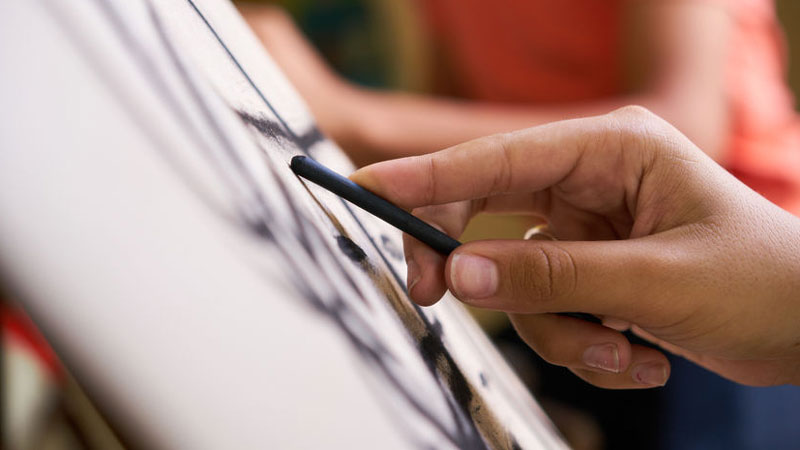
The order of art-making activities presented should be presented in a specific order and should follow a logical progression. Art instruction is linear. The products that your students create should demonstrate growth so that by the end of the year, there is clear improvement.
Curriculum
Your curriculum should be designed and tweaked each year to maximize your effectiveness as a teacher and maximize your time with students.
You should design your entire year’s curriculum before you meet the first student on your roster. You should see the big picture. You are the captain of the ship, the pilot of the plane – you should know where you are going.
You would never get in the car to go somewhere without knowing where you are going. It doesn’t make sense to jump from project to project without a defined goal for your students. You must guide them and you must know where you want them to be.
Your curriculum should be planned and follow a logical progression. We learn addition before we learn subtraction. There’s a reason for this. We learn multiplication before we learn division. We can’t divide unless we fully understand how to multiply.
Therefore, it doesn’t make sense to teach painting before we teach drawing. We shouldn’t teach form before we teach shape, etc. Yet so many teachers jump right into a concept like color theory before even teaching the concepts of value and light. No wonder students get confused.
Over the course of the year, we should evaluate the effectiveness of our lessons. When a lesson fails, replace it. When a lesson succeeds – improve it.
You should see what your students produce improve each year as your delivery and quality of the lesson improves. Keep making your lessons better until they are perfect.
Empathy
Many teachers say they believe in all of their students, but really believe in maybe 80%. In order to teach art effectively, you must believe in all of your students and show it, especially when they don’t believe in themselves.
This may be a real challenge at times. You will always have those students that it seems you’re not reaching. If you’re consistent and authentic, whether you believe it or not, they are listening. Focus on each student as an individual and let them know (frequently) that you are there and genuinely interested in their success. (If you aren’t genuinely interested in their success, get out of teaching.)
Students will respond to authenticity. It may take a while for some students, so don’t give up.
You also must demonstrate that you relate to your students – that you understand their pressures and their schedules – art is not their only class.
Making quality art takes time – set deadlines and expectations but allow students to turn in work late without punishment. We are not tyrants – we are mentors and allies. We are confidence builders not slave drivers.
I once had a very skilled student that took “ages” to complete her art. At the end of the first quarter, she had only turned in half of her assignments, although she was still working on them. I had no choice but to give her an “F”. After the quarter had ended and report cards had been passed out, she turned in the missing assignments. The work was amazing!
What was I to do? Deadlines are important and if art is your job, you get fired for missing them. Should I leave her grade as it was and “teach her a lesson” or should I change it?
The reality is that art was not her job as a student. It was one of her classes – her favorite class. She had several other classes, extracurricular activities, and a job after school. The art assignments were demanding and she cared about the quality of the art that she produced – not the grade that she received. Was she to be punished for this?
I changed her grade. It was the right thing to do. My decision to do so even affected the direction of her life. She later went on to receive a full scholarship from a very prestigious art school. Do you think that she would have gotten that scholarship with an “F” in art on her record?
Confidence goes a long way in making your students successful. You should look for every opportunity to build a student’s confidence. Your words (and actions) are heavy. What you say to students stick with them. Success only happens when it is believed to be possible. You must make students believe that it is. This means that you must fight the talent myth and give students the opportunity to find success. If a student doesn’t believe that they can succeed, then they never will.
More Thoughts
To be an effective teacher, you must be an actor – play yourself!
Try to include a congruent example to illustrate your point. In this post, I included at least one congruent illustration to help you remember the concept and why it is important for every point I made.
Involve your students and let them be active participants in their learning. Ask questions, invoke discussions.
Allow the students to see the real you. Be completely authentic. Students don’t really care what your personality is like, they just want you to be real. It’s okay to make mistakes and admit them. In fact, your students will respect you for it. And if they respect you, they will learn from you.
Lastly, enjoy your job. If you like what you’re doing, it will show. Students will like learning from you. They can smell it when a teacher is not enjoying their job. That teacher’s effectiveness will suffer because of it. Enjoy what you do and effectiveness naturally follows.
Love what you do and let it show every single day. Invest yourself in your craft.
Love your students and even on the worst days, try to remember that you are one of the most important people in their lives.
If so, join over 36,000 others that receive our newsletter with new drawing and painting lessons. Plus, check out three of our course videos and ebooks for free.


